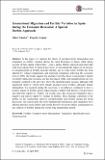Files in this item
International migration and fertility variation in Spain during the economic recession : a spatial Durbin approach
Item metadata
| dc.contributor.author | Sabater, Albert | |
| dc.contributor.author | Graham, Elspeth | |
| dc.date.accessioned | 2018-04-30T09:30:14Z | |
| dc.date.available | 2018-04-30T09:30:14Z | |
| dc.date.issued | 2019-09 | |
| dc.identifier | 252738335 | |
| dc.identifier | f81aafda-a05e-4cdb-9a01-e3c8e9a041a0 | |
| dc.identifier | 85046027483 | |
| dc.identifier | 000480741300003 | |
| dc.identifier.citation | Sabater , A & Graham , E 2019 , ' International migration and fertility variation in Spain during the economic recession : a spatial Durbin approach ' , Applied Spatial Analysis and Policy , vol. 12 , no. 3 , pp. 515-546 . https://doi.org/10.1007/s12061-018-9255-9 | en |
| dc.identifier.issn | 1874-4621 | |
| dc.identifier.uri | https://hdl.handle.net/10023/13260 | |
| dc.description | Funding: UK Economic and Social Research Council (ESRC) grant ES/K007394/1. | en |
| dc.description.abstract | In this paper, we examine the effects of unemployment, immigration and emigration on fertility variation during the Great Recession in Spain, while taking account of trans-spatial relationships. Using a spatial Durbin approach and panel data with observations from 50 Spanish provinces, we investigate the impact of an increase in unemployment on fertility and ask whether, and to what extent, fertility has been affected by reduced immigration and increased emigration following the economic crisis of 2008. Our results suggest that unemployment has had a strong negative impact on fertility during the recession, and that the impact of the total unemployment rate was primarily confined to the province where the unemployment occured, although with significant spillover effects from female unemployment. Further, although female immigration was reduced during the recession, it nevertheless continued to have a positive impact on fertility, and its impact seems to matter both directly (own-province) and indirectly (spillover). Finally, our results show that increased emigration had a negative and indirect (spillover) impact on fertility. These findings contribute to the debate on the relationship between unemployment and fertility during the Great Recession, and demonstrate that both international immigration and emigration have affected province-level fertility and should therefore be given serious consideration in any analysis of fertility during the current long recessionary period. | |
| dc.format.extent | 32 | |
| dc.format.extent | 767059 | |
| dc.language.iso | eng | |
| dc.relation.ispartof | Applied Spatial Analysis and Policy | en |
| dc.subject | Fertility | en |
| dc.subject | Unemployment | en |
| dc.subject | Immigration | en |
| dc.subject | Emigration | en |
| dc.subject | Spanish provinces | en |
| dc.subject | Great Recession | en |
| dc.subject | HB Economic Theory | en |
| dc.subject | HT Communities. Classes. Races | en |
| dc.subject | DP Spain | en |
| dc.subject | 3rd-NDAS | en |
| dc.subject | SDG 5 - Gender Equality | en |
| dc.subject | SDG 8 - Decent Work and Economic Growth | en |
| dc.subject | SDG 10 - Reduced Inequalities | en |
| dc.subject.lcc | HB | en |
| dc.subject.lcc | HT | en |
| dc.subject.lcc | DP | en |
| dc.title | International migration and fertility variation in Spain during the economic recession : a spatial Durbin approach | en |
| dc.type | Journal article | en |
| dc.contributor.sponsor | Economic & Social Research Council | en |
| dc.contributor.institution | University of St Andrews. School of Geography & Sustainable Development | en |
| dc.identifier.doi | 10.1007/s12061-018-9255-9 | |
| dc.description.status | Peer reviewed | en |
| dc.identifier.grantnumber | ES/K007394/1 | en |
This item appears in the following Collection(s)
Items in the St Andrews Research Repository are protected by copyright, with all rights reserved, unless otherwise indicated.

